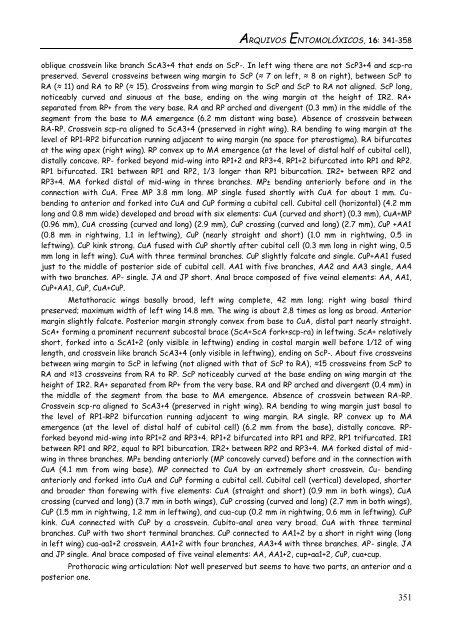ARQUIVOS ENTOMOLÓXICOS ARTIGO / ARTÍCULO / ARTICLE
ae16_2016_petrulevicius_gutierrez_new_basal_odonatoptera_lower_carboniferous_argentina
ae16_2016_petrulevicius_gutierrez_new_basal_odonatoptera_lower_carboniferous_argentina
Create successful ePaper yourself
Turn your PDF publications into a flip-book with our unique Google optimized e-Paper software.
<strong>ARQUIVOS</strong> <strong>ENTOMOLÓXICOS</strong>, 16: 341-358<br />
oblique crossvein like branch ScA3+4 that ends on ScP-. In left wing there are not ScP3+4 and scp-ra<br />
preserved. Several crossveins between wing margin to ScP (≈ 7 on left, ≈ 8 on right), between ScP to<br />
RA (≈ 11) and RA to RP (≈ 15). Crossveins from wing margin to ScP and ScP to RA not aligned. ScP long,<br />
noticeably curved and sinuous at the base, ending on the wing margin at the height of IR2. RA+<br />
separated from RP+ from the very base. RA and RP arched and divergent (0.3 mm) in the middle of the<br />
segment from the base to MA emergence (6.2 mm distant wing base). Absence of crossvein between<br />
RA-RP. Crossvein scp-ra aligned to ScA3+4 (preserved in right wing). RA bending to wing margin at the<br />
level of RP1-RP2 bifurcation running adjacent to wing margin (no space for pterostigma). RA bifurcates<br />
at the wing apex (right wing). RP convex up to MA emergence (at the level of distal half of cubital cell),<br />
distally concave. RP- forked beyond mid-wing into RP1+2 and RP3+4. RP1+2 bifurcated into RP1 and RP2.<br />
RP1 bifurcated. IR1 between RP1 and RP2, 1/3 longer than RP1 biburcation. IR2+ between RP2 and<br />
RP3+4. MA forked distal of mid-wing in three branches. MP± bending anteriorly before and in the<br />
connection with CuA. Free MP 3.8 mm long. MP single fused shortly with CuA for about 1 mm. Cubending<br />
to anterior and forked into CuA and CuP forming a cubital cell. Cubital cell (horizontal) (4.2 mm<br />
long and 0.8 mm wide) developed and broad with six elements: CuA (curved and short) (0.3 mm), CuA+MP<br />
(0.96 mm), CuA crossing (curved and long) (2.9 mm), CuP crossing (curved and long) (2.7 mm), CuP +AA1<br />
(0.8 mm in rightwing, 1.1 in leftwing), CuP (nearly straight and short) (1.0 mm in rightwing, 0.5 in<br />
leftwing). CuP kink strong. CuA fused with CuP shortly after cubital cell (0.3 mm long in right wing, 0.5<br />
mm long in left wing). CuA with three terminal branches. CuP slightly falcate and single. CuP+AA1 fused<br />
just to the middle of posterior side of cubital cell. AA1 with five branches, AA2 and AA3 single, AA4<br />
with two branches. AP- single. JA and JP short. Anal brace composed of five veinal elements: AA, AA1,<br />
CuP+AA1, CuP, CuA+CuP.<br />
Metathoracic wings basally broad, left wing complete, 42 mm long; right wing basal third<br />
preserved; maximum width of left wing 14.8 mm. The wing is about 2.8 times as long as broad. Anterior<br />
margin slightly falcate. Posterior margin strongly convex from base to CuA, distal part nearly straight.<br />
ScA+ forming a prominent recurrent subcostal brace (ScA+ScA fork+scp-ra) in leftwing. ScA+ relatively<br />
short, forked into a ScA1+2 (only visible in leftwing) ending in costal margin well before 1/12 of wing<br />
length, and crossvein like branch ScA3+4 (only visible in leftwing), ending on ScP-. About five crossveins<br />
between wing margin to ScP in lefwing (not aligned with that of ScP to RA), ≈15 crossveins from ScP to<br />
RA and ≈13 crossveins from RA to RP. ScP noticeably curved at the base ending on wing margin at the<br />
height of IR2. RA+ separated from RP+ from the very base. RA and RP arched and divergent (0.4 mm) in<br />
the middle of the segment from the base to MA emergence. Absence of crossvein between RA-RP.<br />
Crossvein scp-ra aligned to ScA3+4 (preserved in right wing). RA bending to wing margin just basal to<br />
the level of RP1-RP2 bifurcation running adjacent to wing margin. RA single. RP convex up to MA<br />
emergence (at the level of distal half of cubital cell) (6.2 mm from the base), distally concave. RPforked<br />
beyond mid-wing into RP1+2 and RP3+4. RP1+2 bifurcated into RP1 and RP2. RP1 trifurcated. IR1<br />
between RP1 and RP2, equal to RP1 biburcation. IR2+ between RP2 and RP3+4. MA forked distal of midwing<br />
in three branches. MP± bending anteriorly (MP concavely curved) before and in the connection with<br />
CuA (4.1 mm from wing base). MP connected to CuA by an extremely short crossvein. Cu- bending<br />
anteriorly and forked into CuA and CuP forming a cubital cell. Cubital cell (vertical) developed, shorter<br />
and broader than forewing with five elements: CuA (straight and short) (0.9 mm in both wings), CuA<br />
crossing (curved and long) (3.7 mm in both wings), CuP crossing (curved and long) (2.7 mm in both wings),<br />
CuP (1.5 mm in rightwing, 1.2 mm in leftwing), and cua-cup (0.2 mm in rightwing, 0.6 mm in leftwing). CuP<br />
kink. CuA connected with CuP by a crossvein. Cubito-anal area very broad. CuA with three terminal<br />
branches. CuP with two short terminal branches. CuP connected to AA1+2 by a short in right wing (long<br />
in left wing) cua-aa1+2 crossvein. AA1+2 with four branches, AA3+4 with three branches. AP- single. JA<br />
and JP single. Anal brace composed of five veinal elements: AA, AA1+2, cup+aa1+2, CuP, cua+cup.<br />
Prothoracic wing articulation: Not well preserved but seems to have two parts, an anterior and a<br />
posterior one.<br />
351


